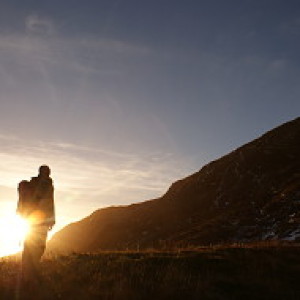Great End
This is the monitoring team on the slopes of Scafell, camped next to Sprinkling Tarn with Great End looming behind. From left to right: Simon, Paul, Mike, Karen and Matt. We had toiled up from Seathwaite with heavy packs in the afternoon, and were here enjoying a meal and a celebratory plastic mug of wine.
The purpose of the visit was to monitor the vegetation of the Scafell Site of Special Scientific Interest. Scafell is of course the highest mountain in England. It takes a minimum of two and a half hours to get to any part of this huge upland massif from the office in Kendal. Camping overnight would enable us to get an early start on Tuesday, as well as allowing some work on Monday evening.
Matt and I began monitoring the site in 2009, but were unable to finish it because of worsening weather conditions at the end of the year. This is the wettest place in England and on one occasion we were forced to abandon the trip after yomping all the way up to Sty Head Tarn because of torrential rain and leaking waterproofs. The next date we were due to visit coincided with the November deluge in the Lake District where over 12 inches of rain fell in 24 hours on Seathwaite. There was no point in even setting out from the office that time.
Anyway, we made it up today. We spent the evening looking at the blocky screes below Great End, then Simon and I scrambled half way up one of the gullies to relocate the only plants of dwarf cornel that are known in Cumbria. There are no more than 30 plants on a ledge, a needle in a haystack to find, but Simon's unerring visual memory took us to the spot where he first found it 5 years ago (when he and I and his wife Jean were looking for another plant).
Great End is the crag that Coleridge, on descending from Scafell, slithered down and somehow survived, his account of this epic being published in the Tour in the Lake Country 1802. It's a rugged and forbidding crag, incised by several deep gullies. Few people have botanised here, and hence how a plant had remained unseen until five years ago.
Anyway, seeing the Dwarf Cornel again (and surviving the slither back down) made a great end to the day. Here is a picture of the Dwarf Cornel taken under more optimal conditions than the picture I took with flash as the light failed.
The exposure and composition of this blip may betray the fact that this was taken on self-timer with the camera balanced on a rock.
See also the entry by brokenbanjo

Comments
Sign in or get an account to comment.


